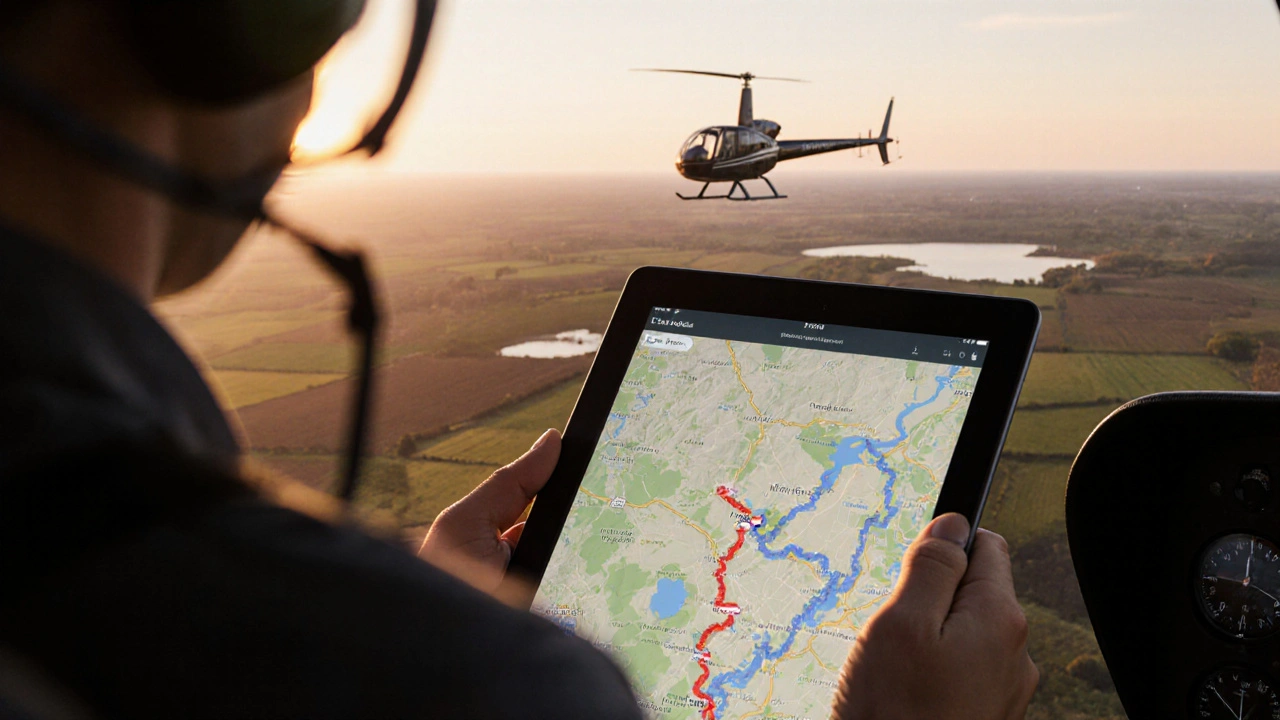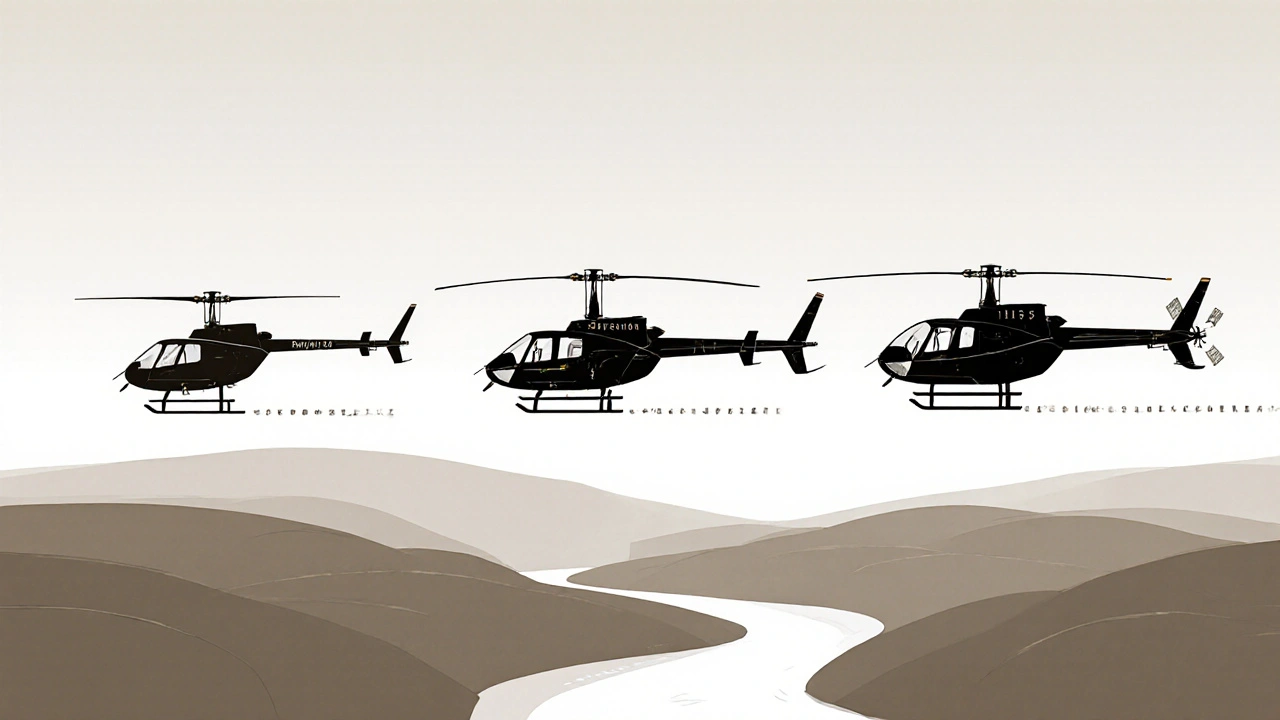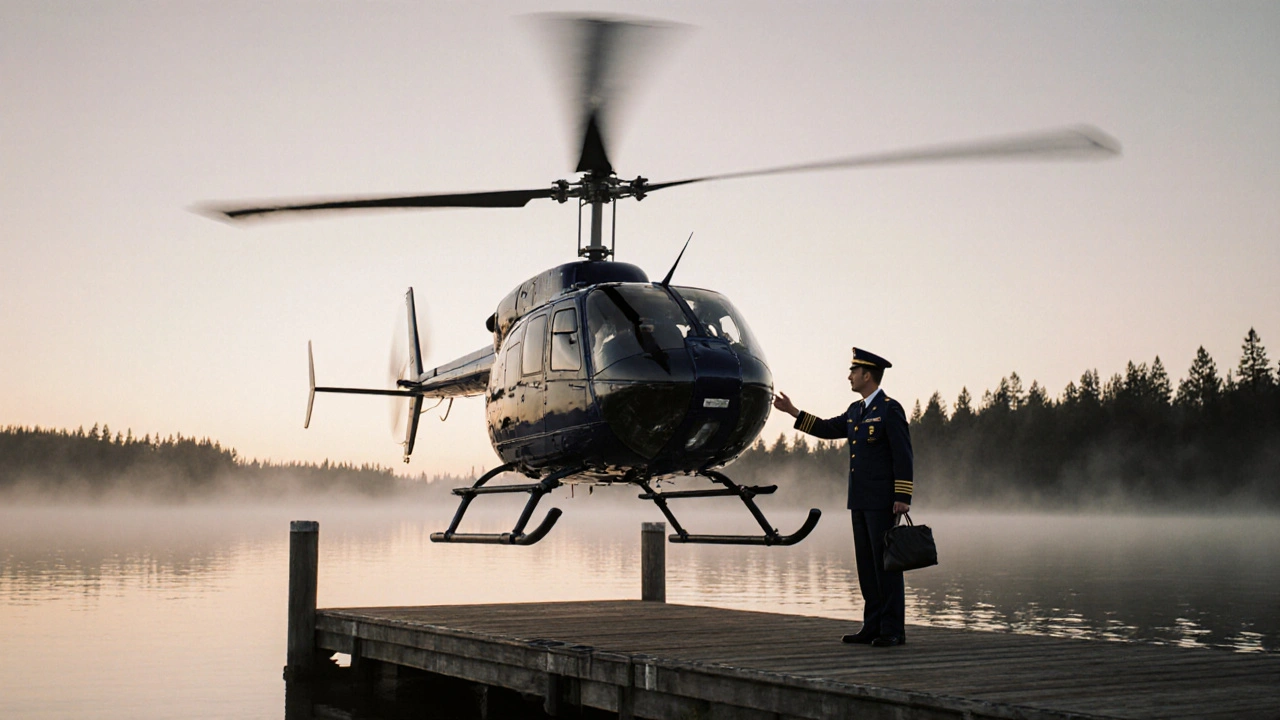Helicopter Speed: How Long Does 6 Miles Take?

Helicopter Travel Time Calculator
Calculate Your 6-Mile Helicopter Flight Time
Estimate travel time for 6 miles based on helicopter model, wind conditions, and altitude. Results include practical adjustments for real-world factors.
Estimated Travel Time
Key Takeaways
- Typical cruise speeds for light helicopters range from 90‑130mph, so 6miles usually takes 3‑4minutes.
- Factors like wind, altitude, and pilot technique can add or shave off a minute.
- Use a simple formula - Time = Distance ÷ Speed - or an online calculator for quick answers.
- Different models (Robinson R44, Bell 206, Airbus H125) have noticeably different times for the same distance.
- Check weather, fuel, and clearances before planning short hops.
Ever stared at a map, picked a point six miles away, and wondered how long you’d actually be in the air? If you’re thinking about a helicopter ride - maybe a quick lake drop‑off, a scenic tour, or an emergency pickup - the answer hinges on a few concrete numbers and a dash of real‑world context. Below we break down the math, the variables, and the real‑life examples you need to estimate helicopter travel time for a 6‑mile leg.
What Is a Helicopter, Anyway?
Helicopter is a rotary‑wing aircraft capable of vertical take‑off, hovering, and forward flight by varying the pitch of its main rotor blades. It’s the go‑to machine when you need flexibility that fixed‑wing planes can’t offer. Because helicopters can lift straight up and down, the distance you cover isn’t limited by runways - it’s all about how fast the rotors spin and how the pilot manages that speed.
How Fast Do Helicopters Usually Fly?
When we talk about speed, we’re really referring to airspeed - the speed of the aircraft relative to the surrounding air. Most civilian light‑utility helicopters cruise between 90 and 130mph (145‑210km/h). Here’s a quick snapshot of three popular models:
| Model | Cruise Speed (mph) | Time for 6mi (minutes) |
|---|---|---|
| Robinson R44 | 110 | 3.3 |
| Bell 206 JetRanger | 115 | 3.1 |
| Airbus H125 (formerly AS350) | 130 | 2.8 |

Simple Math: Distance ÷ Speed = Time
The core calculation is straightforward:
- Convert the speed to miles per minute (mph ÷ 60).
- Divide the distance (6miles) by that value.
For a 110‑mph cruise, the math looks like this:
- 110mph ÷ 60 = 1.83mi/min
- 6mi ÷ 1.83mi/min ≈ 3.28minutes
That’s the baseline - the time you’d log if the air were perfectly still and you kept a steady cruise.
Real‑World Factors That Shift the Clock
In practice, a handful of variables can stretch or shrink that three‑minute window.
1. Wind
Weather conditions - especially wind speed and direction - directly impact a helicopter’s ground speed. A headwind of 10mph reduces your effective ground speed to 100mph, bumping the 6‑mile leg up to about 3.6minutes. Conversely, a tailwind can shave a few seconds off.
2. Altitude
Higher altitude means thinner air, which reduces rotor efficiency and trims cruise speed a bit. At 5,000ft you might lose 5‑10% of top speed, adding roughly 10‑15seconds.
3. Pilot Technique
Every Pilot has a personal “comfort cruise” - some fly a little slower for fuel savings, others push the envelope for a quicker hop. A conservative pilot cruising at 95mph will need about 3.8minutes for 6miles.
4. Flight Path Geometry
If you can’t fly a straight line because of terrain, obstacles, or air‑traffic constraints, the actual distance flown could be longer than the map distance. Adding a half‑mile detour bumps the time up by roughly 30seconds at typical speeds.
5. Fuel & Load
Heavier loads or low‑fuel conditions can compel a pilot to keep a lower power setting, again trimming speed by a few knots. The effect is small over a six‑mile segment but worth mentioning for precision.
Step‑by‑Step Calculator for a Quick Estimate
If you need a fast answer without pulling out a spreadsheet, follow these five steps:
- Pick the helicopter model you’ll be using (or a typical cruise speed range).
- Adjust the cruise speed for wind: Effective Speed = Cruise Speed ± Head/Tailwind.
- Factor altitude loss: subtract 5% for every 2,000ft above sea level.
- Convert to miles per minute (speed ÷ 60).
- Divide 6miles by the adjusted miles‑per‑minute value.
Let’s run a scenario: a Bell 206 cruising at 115mph, 10mph headwind, flying at 3,000ft.
- Effective speed = 115−10 = 105mph.
- Altitude adjustment (≈7% drop) → 105×0.93 ≈ 98mph.
- 98÷60 ≈ 1.63mi/min.
- 6÷1.63 ≈ 3.68minutes.
So you’d budget about 3¾ minutes for that leg.
Checklist: Quick Estimation at a Glance
- Identify helicopter model and its published cruise speed.
- Check current wind forecast (direction + speed).
- Note field elevation or expected flight altitude.
- Adjust speed for wind and altitude.
- Use Time = Distance ÷ Adjusted Speed.
- Add a safety buffer (30‑60seconds) for unforeseen delays.

Why Knowing This Matters
Whether you’re planning a scenic hop over a national park, coordinating a medical evacuation, or just curious about the buzz of a helicopter ride, having a realistic time frame helps you:
- Synchronize with ground transportation or tour schedules.
- Communicate accurate ETAs to guests or emergency responders.
- Manage fuel budgeting for short‑range missions.
And, let’s be honest - it feels cool to say, “We’ll be there in three minutes flat!” when you actually understand the numbers behind it.
Common Misconceptions
People often assume that helicopters are always faster than cars for short distances because they fly straight. That’s true only when you factor in the time spent on boarding, pre‑flight checks, and clearance. In many cases, a well‑planned car ride can rival a three‑minute helicopter hop, especially if traffic is light.
Beyond Six Miles: Scaling the Formula
The same calculation works for any distance. Just swap the 6miles for whatever you need, keep the speed adjustments, and you’ll have a reliable estimate for longer trips - whether you’re heading to a remote ranch (15mi) or crossing a lake (2mi).
Frequently Asked Questions
How does a helicopter’s vertical take‑off affect travel time?
Vertical take‑off adds only a few seconds compared to a runway‑roll for a short hop. The real time factor is cruise speed and wind.
Can I use a car GPS to estimate helicopter flight time?
Car GPS gives road distance, not straight‑line aerial distance. For helicopters you need the great‑circle or direct line distance, then apply airspeed.
Do helicopters consume a lot of fuel on a 6‑mile leg?
Fuel burn is roughly 15‑20gallons per hour for light models. For a three‑minute flight that’s only 0.75‑1gallon, so fuel isn’t a limiting factor.
What safety checks should I do before a short helicopter flight?
Pre‑flight checks include: rotor integrity, fuel level, engine oil, weather briefing, and clearances from air traffic control. Even for six miles, these steps are non‑negotiable.
Is there a rule of thumb for estimating helicopter time without calculations?
Yes-divide the distance by 100mph and multiply by 60. For 6miles, 6 ÷ 100 = 0.06hours, or about 3.6minutes. Adjust up or down for wind and altitude.
Now you’ve got the numbers, the variables, and the quick‑calc steps to answer the simple question, “How long is 6 miles in a helicopter?” Whether you’re a tourist, a pilot, or just a curious mind, you can proudly give a precise estimate and know exactly why it might shift by a minute or two.